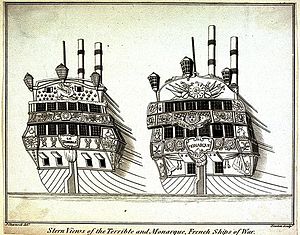
Admiral of the Blue Edward Boscawen, PC was a British admiral in the Royal Navy and Member of Parliament for the borough of Truro, Cornwall, England. He is known principally for his various naval commands during the 18th century and the engagements that he won, including the siege of Louisburg in 1758 and Battle of Lagos in 1759. He is also remembered as the officer who signed the warrant authorising the execution of Admiral John Byng in 1757, for failing to engage the enemy at the Battle of Minorca (1756). In his political role, he served as a Member of Parliament for Truro from 1742 until his death although due to almost constant naval employment he seems not to have been particularly active. He also served as one of the Lords Commissioners of the Admiralty on the Board of Admiralty from 1751 and as a member of the Privy Council from 1758 until his death in 1761.

Edward Hawke, 1st Baron Hawke,, of Scarthingwell Hall in the parish of Saxton with Scarthingwell, near Tadcaster, Yorkshire, was a Royal Navy officer. As captain of the third-rate HMS Berwick, he took part in the Battle of Toulon in February 1744 during the War of the Austrian Succession. He also captured six ships of a French squadron in the Bay of Biscay in the Second Battle of Cape Finisterre in October 1747.

Admiral of the Fleet George Anson, 1st Baron Anson, was a British Royal Navy officer, politician and peer from the Anson family.

Vice-Admiral Sir John Lockhart-Ross, 6th Baronet, known as John Lockhart from 1721 to 1760, was an officer of the Royal Navy who saw service during the War of the Austrian Succession, Seven Years' War, and the American War of Independence, and served for a time as a Member of Parliament.

Admiral John Byng was a British Royal Navy officer who was court-martialled and executed by firing squad. After joining the navy at the age of thirteen, he participated at the Battle of Cape Passaro in 1718. Over the next thirty years he built up a reputation as a solid naval officer and received promotion to vice-admiral in 1747. He also served as Commodore-Governor of Newfoundland Colony in 1742, Commander-in-Chief, Leith, 1745 to 1746 and was a member of Parliament from 1751 until his death.
Five ships of the Royal Navy have been named HMS Monarch.

Admiral Henry Osborn was a British naval officer who served as Commodore-Governor of Newfoundland. He was a younger son of Sir John Osborn, 2nd Baronet.

Vice-Admiral Sir Joshua Rowley, 1st Baronet was a Royal Navy officer who was the fourth son of Admiral Sir William Rowley. Sir Joshua was from an ancient English family, originating in Staffordshire (England) and was born on 1 May 1734. Rowley served with distinction in a number of battles throughout his career and was highly praised by his contemporaries. Unfortunately whilst his career was often active he did not have the opportunity to command any significant engagements and always followed rather than led. His achievements have therefore been eclipsed by his contemporaries such as Keppel, Hawke, Howe and Rodney. Rowley however remains one of the stalwart commanders of the wooden walls that kept Britain safe for so long.

HMS Expedition was a 70-gun third-rate ship of the line built at Portsmouth Dockyard in 1677/79. She was in active commission during the War of the English Succession participating in the battles of Beachy Head and Barfleur. She was rebuilt in 1699. Again, for the War of Spanish Succession she was in commission for the operation at Cadiz then returned to England where she sat for two years. She was in the Mediterranean for the Battle of Marbella in 1705. She then went to the West Indies and fought in Wager's action off Cartagena in 1708. She was rebuilt in 1709-14 to the 1706 Establishment. She spent her time split between the Baltic and as guard ship at Portsmouth before being broken at Portsmouth in 1736. She was rebuilt in 1736/40 at Deptford Dockyard.
HMS Kent was a 64-gun third rate ship of the line of the Royal Navy. She was ordered from Deptford Dockyard on 10 May 1743 and was built by Joseph Allin the younger to the 1741 proposals of the 1719 Establishment, and was launched on 10 May 1746. Her first commander was Thomas Fox, who had previously commanded HMS Newcastle.
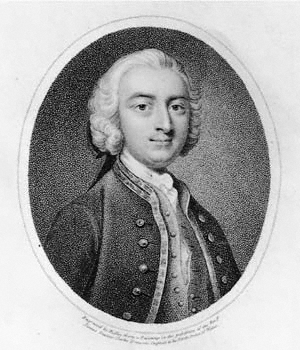
Admiral Sir John Moore, 1st Baronet, KB was a British officer of the Royal Navy during the War of the Austrian Succession and the Seven Years' War. He eventually rose to the rank of admiral.

HMS Tiger or Tygre was a 60-gun fourth rate ship of the line of the Royal Navy, built at Rotherhithe to the draught specified by the 1745 Establishment and launched on 23 November 1747.
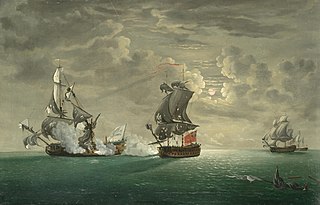
The Battle of Cartagena took place on 28 February 1758 off the Spanish port of Cartagena during the Seven Years' War. A British fleet under Henry Osborn, which had blockaded a French fleet in Cartagena, attacked and defeated a French force under Michel-Ange Duquesne de Menneville coming to their assistance.

Terrible was originally a 74-gun ship of the line of the French Navy launched in 1739. Captured on 14 October 1747, she was taken into Royal Navy service as the third rate HMS Terrible.
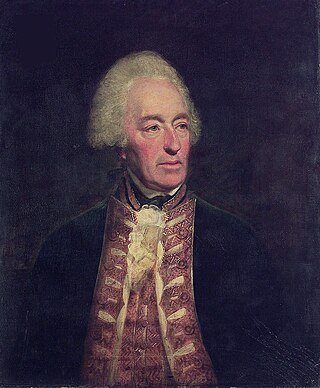
Robert Roddam was an officer of the Royal Navy who saw service during the War of the Austrian Succession, the Seven Years' War, and the American War of Independence. He survived to see the French Revolutionary and Napoleonic Wars, but was not actively employed during them.

Le Magnanime was originally a 74-gun ship of the line of the French Navy launched in 1744 at Rochefort. Captured on 12 January 1748, she was taken into Royal Navy service as the third rate HMS Magnanime. She played a major part in the 1757 Rochefort expedition, helping to silence the batteries on the Isle of Aix, and served at the Battle of Quiberon Bay in 1759 under Lord Howe, where she forced the surrender of the French 74-gun Héros. Following a survey in 1770, she was deemed unseaworthy and was broken up in 1775.
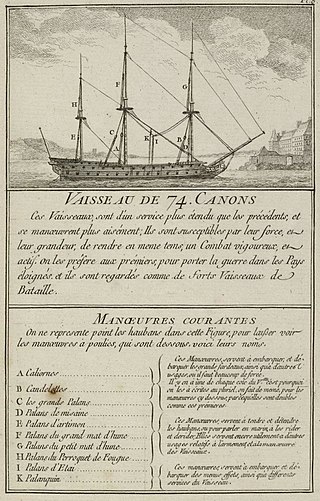
Intrépide was a 74-gun ship of the line of the French Navy. She was of three ships of the Monarque class, all launched in 1747, the others being Monarque and Sceptre.
HMS Weazel or Weazle was a 16-gun ship-sloop of the Royal Navy, in active service during the War of the Austrian Succession, the Seven Years' War and the American Revolutionary War. Launched in 1745, she remained in British service until 1779 and captured a total of 11 enemy vessels. She was also present, but not actively engaged, at the Second Battle of Cape Finisterre in 1747.

The Western Squadron was a squadron or formation of the Royal Navy based at Plymouth Dockyard. It operated in waters of the English Channel, the Western Approaches, and the North Atlantic. It defended British trade sea lanes from 1650 to 1814 and 1831 to 1854. Following Admiralty orders to Lord Anson he was instructed to combine all existing commands in the English Channel - those at the Downs, Narrow Seas, Plymouth and the Spithead - under a centralized command under the Commander-in-Chief, Western Squadron in 1746. The squadron was commanded by the Flag Officer with the dual title of Commander-in-Chief, English Channel and Commander-in-Chief, Western Squadron
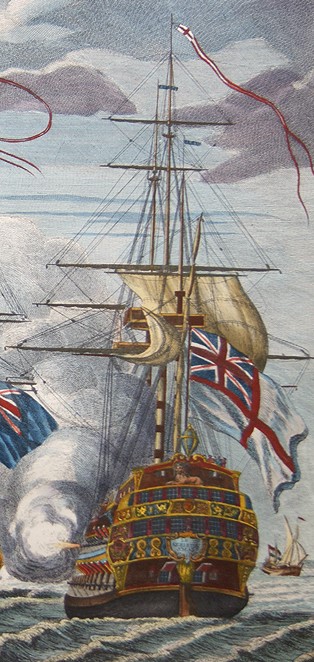
HMS Intrepid was a 64-gun third rate ship of the line of the Royal Navy, originally built in Toulon for the French Navy. She was launched in 1740, as Sérieux and fought at the Battle of Toulon before her capture by the British at the First Battle of Cape Finisterre in 1747. After being renamed and refitted by the Royal Navy, she entered British service in late 1747. Between 1748 and 1752 she was assigned as a guard ship off the coast of Kent in south-east England.
